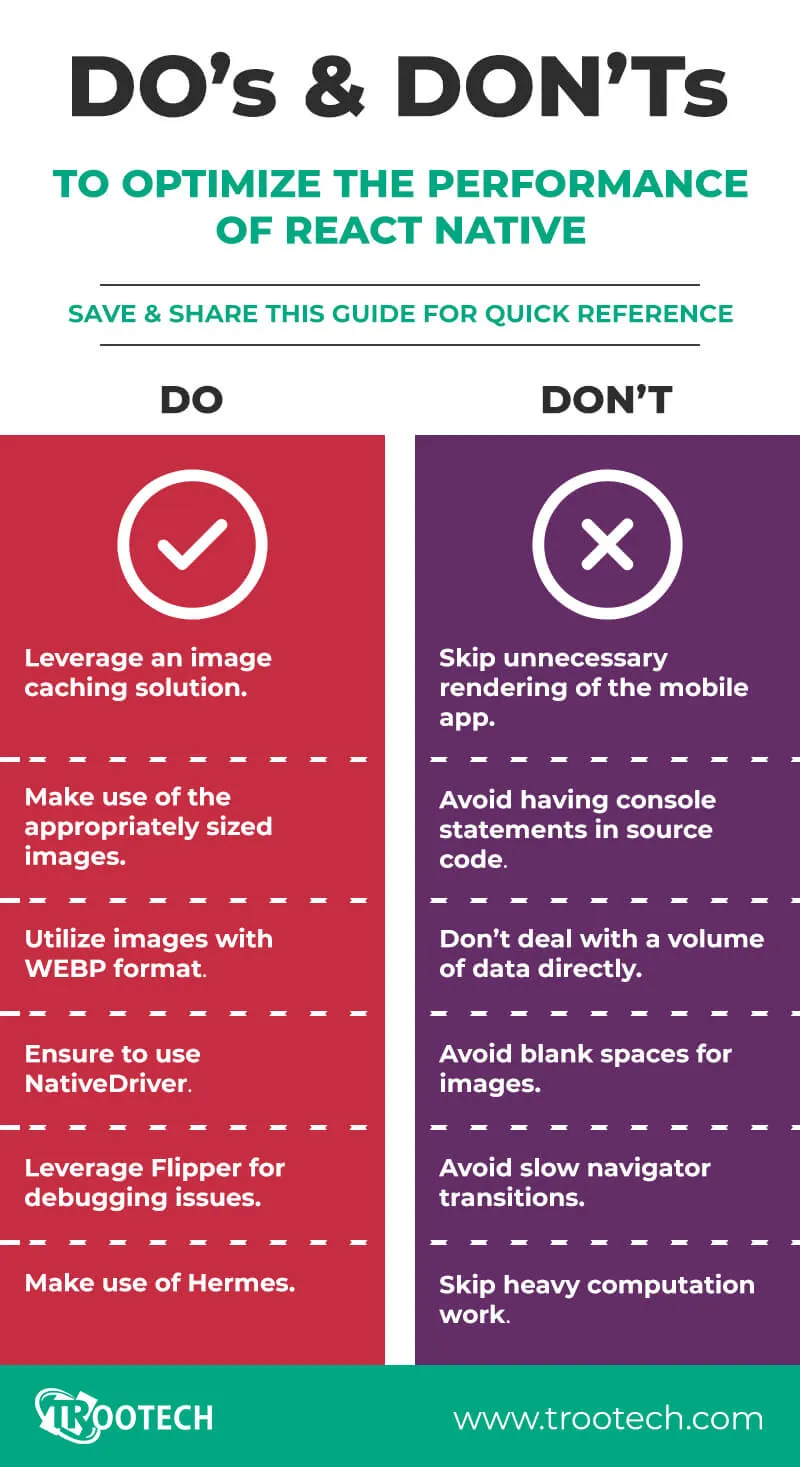How to Optimize the Performance of React Native App: A Detailed Guide

Since we are living in the Internet age, users have more expectations from their applications than from their groceries. Users prefer everything delivered to them instantly, especially the digital experience, and a slow-performing app can be a buzz kill.
With React Native, the problem can be tackled efficiently.
But the underlying how remains. And, we are going to answer the same briefly.
From the time of its inception, React Native has drastically changed the lives and working capabilities of frontend developers. React can be used to develop a more intuitive UI than ever. As a result, frontend developers are able to achieve a sleek and appealing web application.
If you wish to optimize the performance of React Native app, you need to employ the right solutions. However, to achieve a high-performing application, we need to know common challenges first.
What are the Top Challenges and Solutions to Optimize the Performance of React Native App?

The top reason why frontend developers swear by the use of React is owing to the near-native performance. Despite the fact that React is not a native language for building mobile applications, it still enables you to build a native application with better productivity, speed, and an easy development process. However, some React Native challenges often pop up in the way of building a high-performant app, which needs to be chipped off.
Let’s take a look at these issues:
Navigation Issues
Though React Native offer excellent performance, it shows some potential issues when it comes to the usability of the app. Similar to the overall performance of the application, navigational performance is of utmost importance. If the navigational performance in a mobile application is not as smooth as it should be, it might mislead the user.
Difficulty in the navigation of a mobile application might lead to difficulty in accessing the app features. As a result, users might just gradually move out of your app usage’s radar. Bad navigation can often make it tough for your users to move from one screen to the other screen.
Potential Solution for Navigation Issues:
React Native provides you with four potential, solutions to improve the navigation ability of your mobile application:
- Navigator iOS: It can be used to build better navigation for iOS apps.
- React Navigation: It offers a way for users to have smooth transitions between screens.
- Navigator: It is used for prototype development or for small applications. It is not appropriate for complicated app development processes.
- Navigation Experiment: You can use the Navigation experiment for building the navigation of large applications.
Launch Time
One of the key issues while using a mobile application is the launch time. Users dread slow launch time. On average, if a mobile application takes more than five seconds to launch, users leave it on its fate and move to any other application. There are numerous potential issues that add up to the delayed app launch response.
If your mobile application is built with too many dependencies, these could slow the performance of your mobile app. In addition to this, the Object. Finalize element is also responsible for increasing the launch time of the mobile app. Since too many finalizers exhaust the memory, the app often shows out-of-memory errors.
Potential Solution for Launch Time Delay:
Since the default implementations of React Native causes a delay in the launch time, you can start to optimize the performance of your app with the Object. finalize element. The finalizers operate on a single thread. As a result, other objects need to wait till the finalizers have moved through. Owing to these dependencies, the app lags in performance.
In such a case, you can reduce the number of dependencies in your mobile application and try using high-performance and fast components.
Memory Leakage
Memory leakage is a prominent issue that React Native developers face. In case you are unsure about the nature of the memory leakage, it shows a warning–Can’t perform a React state update on an unmounted component. Of course, this is a no-op, but it indicates a memory leak in your application. To fix, cancel all subscriptions and asynchronous tasks in a useEffect cleanup function. When you encounter such a warning, it shows that your app is suffering from memory leakage.
In addition to this, memory leakage will happen in your application if the API server or the host takes some time for response. Despite the component being unmounted, the response will still be on completion.
Potential Solution for Memory Leakage:
In order to fix the memory leakage issue in React Native, you need to cancel all the subscriptions as well as asynchronous tasks in the useEffect cleanup function. In such a case, you can use scrolling lists such as SectionList, VirtualList, or FlatList instead of using ListView. This way, the unnecessary processes operating in the background can be brought to a halt.
Large Size of the Mobile Application
A key difference between the Native apps and React Native apps is that the latter is larger in size. The size of the mobile application is larger in size than the native mobile applications. The React Native mobile application will rise when you use multiple third-party libraries as well as native components.
Images and media larger in size in a mobile application can also lead to high memory usage, which, in turn, increases the size of the mobile application. If the graphical content or images take up a lot of space of the application, it may lead to an app crash, owing to the memory overload and impact the performance of the React Native mobile application.
Potential Solution to reduce the Size of the Mobile Application:
The size of mobile applications often slows down the mobile and web applications. The use of multiple third-party libraries as well as native components. In order to reduce the mobile application size, you can try to incorporate a fewer number of third-party libraries as well as components.
In addition to this, you can also try compressing the images to optimize the performance of React Native app to decrease the size of the application.
Multi-threading Issues in React Native
Unlike the usual JavaScripts, React Native does not extend support to multiple threads. Therefore, when React Native renders one component, other components need to wait until the first component is rendered.
Several mobile applications, including Twitch scramble away from React Native, owing to such challenges. Furthermore, when an application implements or introduces new features, it impacts low-end devices. Hence, when new features or functionalities are being added to a mobile application, multi-threading issues occur within the applications.
Potential Solution to Fix the Multi-threading Issues in React Native:
In order to fix the multi-threading issue in React Native, you can develop your extension code for taking care of multithreading. Since there is no support for React Native, you can create your customized code with an intense focus on maintainability and system design.
Using the extension code, you can develop a bridge between native and React Native components. You can write these extension codes using Swift, Objective C, and Java.
Dos and Don’ts to Know to Optimize the Performance of React Native App

As compared to other frontend programming languages, React Native offers a speedy performance by default. When you are building a React Native mobile application, you might need to bring some ramifications to build real-world React Native applications.
In this section, we offer a comprehensive and exclusive list of suggestions to optimize the performance of your React Native:
| Dos | Don’ts |
|---|---|
| Leverage an image caching solution to avoid rendering multiple images on a single screen. | Skip unnecessary rendering of the mobile application to optimize the performance of React Native. |
| Make use of the appropriately sized images. You can make use of the PNG format of images instead of JPG. In addition to this, you should use small-sized images to contain the space of images. | Avoid having console statements in source code to optimize the performance of React Native app. When you leave the console statements behind, it might lead to multiple challenges in the JavaScript thread. |
| Utilize images with WEBP format to reduce the binary size on Android and iOS devices by at least 29%. | Don’t deal with a volume of data directly. In order to achieve scrollable lists in React Native, make use of Scrollview to transverse an extensive list of data through JavaScript’s map(). In addition to this, you can also use FlatList to make sure that the data items are loaded and that the application does not consume a lot of data. |
| Ensure to use nativeDriver along with Animated library for creating animations while building a React Native application. | Avoid blank spaces for images. If a user has poor Internet connectivity, you can use image placeholders in React Native or Progressive image component to load the thumbnail and fade it for providing the actual time required for the image to load. |
| Leverage Flipper for debugging issues. While using Flipper, it does not need remote debugging. However, it needs a locally well-established Metro instance for interacting with the React Native mobile application. | Avoid slow navigator transitions. When JavaScript thread assumes control of navigator animations, React tries to render a new screen. In such a case, you can use interaction manager to optimize the performance of React Native application. |
| Make use of Hermes, which is available for all Android platforms. It enables an effective reduction in the size of a mobile app. In addition to this, it also helps decrease memory consumption. Using Hermes decreases the time taken for a mobile application to turn stable. | Skip heavy computation work with the JavaScript thread. Instead, you can utilize an Animated library with Native driver to increase achieve the most interpolation work in less time. |
What Should Every React Developer Know Before Working with React Native?

In recent times, React Native as a frontend programming language has caught the attention of developers and business owners. As a result, more and more individuals are encountering the issues and looking for viable solutions to optimize the performance of React Native app. While you are good to work with React Native by following the dos and don’ts mentioned above, there are numerous tools that you should know about:
- Flow: It can be defined as a static type checker for JS. If you find it time-consuming to execute your code for finding the bugs, you can use Flow to identify your bugs while you code, thereby putting more minutes into your watch.
- ESLint: ESLint analyzes your written code to help you get to the root of the problems. It is developed into the most efficient text editors and can execute ESLint for a continuous integration pipeline.
- React Navigation: React Navigation is easy to use and extensible for enabling developers to write their own navigators.
- Prettier: Prettier is an advanced code formatter, which helps you save energy and time. It integrates with most editors and supports numerous programming languages.
- Sentry: Sentry offers performance monitoring and error tracking for developers to solve the errors and develop sustainable applications.
- CodePush: CodePush quickly hotfixes through release branches into your deployments and determines the root cause of underlying issues for quick diagnoses and fixes in the application.
- Expo: Expo offers efficient handling of the crucial parts so developers do not have to use Xcode or Android Studio for submitting the application and enabling it to reach out to end-users.
Over 50% of the issues with React Native can be fixed with a few adjustments and workaround. If it still doesn’t get fixed, you always have got our expert’s back to optimize the performance of your React Native app.

